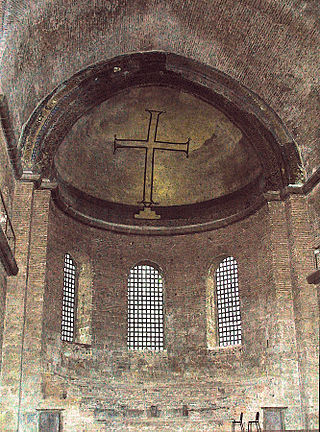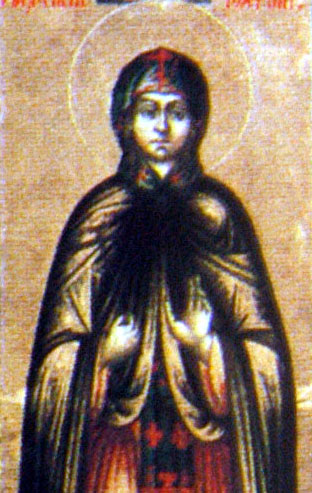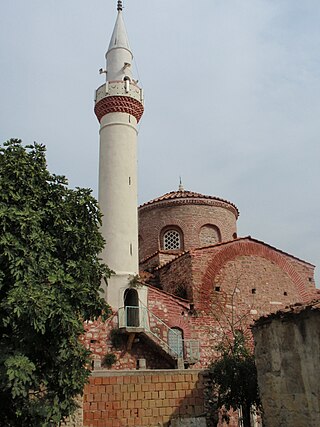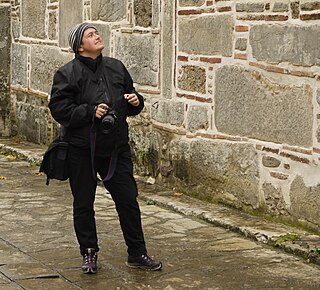Related Research Articles

Leo V the Armenian was the Byzantine emperor from 813 to 820. A senior general, he forced his predecessor, Michael I Rangabe, to abdicate and assumed the throne. He ended the decade-long war with the Bulgars, and initiated the second period of Byzantine Iconoclasm. He was assassinated by supporters of Michael the Amorian, one of his most trusted generals, who succeeded him on the throne.

Tiberius III, born Apsimar, was Byzantine emperor from 698 to 705. Little is known about his early life, other than that he was a droungarios, a mid-level commander, who served in the Cibyrrhaeot Theme. In 696, Tiberius was part of an army sent by Byzantine Emperor Leontius to retake the North African city of Carthage, which had been captured by the Arab Umayyads. After seizing the city, this army was pushed back by Umayyad reinforcements and retreated to the island of Crete. As they feared the wrath of Leontius, some officers killed their commander, John the Patrician, and declared Tiberius the emperor. Tiberius swiftly gathered a fleet and sailed for Constantinople, where he then deposed Leontius. Tiberius did not attempt to retake Byzantine Africa from the Umayyads, but campaigned against them along the eastern border with some success. In 705, former emperor Justinian II, who had been deposed by Leontius, led an army of Slavs and Bulgars from the First Bulgarian Empire to Constantinople, and after entering the city secretly, deposed Tiberius. Tiberius fled to Bithynia, but was captured a few months later and beheaded by Justinian between August 705 and February 706. His body was initially thrown into the sea, but was later recovered and buried in a church on the island of Prote.

Constantine V was Byzantine emperor from 741 to 775. His reign saw a consolidation of Byzantine security from external threats. As an able military leader, Constantine took advantage of civil war in the Muslim world to make limited offensives on the Arab frontier. With this eastern frontier secure, he undertook repeated campaigns against the Bulgars in the Balkans. His military activity, and policy of settling Christian populations from the Arab frontier in Thrace, made Byzantium's hold on its Balkan territories more secure.
Byzantine art comprises the body of artistic products of the Eastern Roman Empire, as well as the nations and states that inherited culturally from the empire. Though the empire itself emerged from the decline of Rome and lasted until the Fall of Constantinople in 1453, the start date of the Byzantine period is rather clearer in art history than in political history, if still imprecise. Many Eastern Orthodox states in Eastern Europe, as well as to some degree the Islamic states of the eastern Mediterranean, preserved many aspects of the empire's culture and art for centuries afterward.
Antony IKassymatas, Ecumenical Patriarch of Constantinople from January 821 to January 837.

The Byzantine Iconoclasm were two periods in the history of the Byzantine Empire when the use of religious images or icons was opposed by religious and imperial authorities within the Ecumenical Patriarchate and the temporal imperial hierarchy. The First Iconoclasm, as it is sometimes called, occurred between about 726 and 787, while the Second Iconoclasm occurred between 814 and 842. According to the traditional view, Byzantine Iconoclasm was started by a ban on religious images promulgated by the Byzantine Emperor Leo III the Isaurian, and continued under his successors. It was accompanied by widespread destruction of religious images and persecution of supporters of the veneration of images. The Papacy remained firmly in support of the use of religious images throughout the period, and the whole episode widened the growing divergence between the Byzantine and Carolingian traditions in what was still a unified European Church, as well as facilitating the reduction or removal of Byzantine political control over parts of the Italian Peninsula.
Andrew of Crete was a fervent iconophile, he was executed in the Forum Bovis of Constantinople at the orders of Emperor Constantine V in 766 or 767, during the Byzantine Iconoclasm. He is regarded as a martyr in the Catholic and Eastern Orthodox churches. His feast day is October 17. The monastery of St Andrew in Krisei in Constantinople, currently the Koca Mustafa Pasha Mosque in Istanbul, was dedicated to him. It should be noticed that according to modern sources, the figure of Andrew of Crete, like those of many iconophile Saints lived under the iconoclastic period, is unverified.

Judith Herrin is a British archaeologist, byzantinist, and historian of Late Antiquity. She was a Professor of Late Antique and Byzantine Studies and Constantine Leventis Senior Research Fellow at King's College London.

Saint Theodosia of Constantinople is a Christian nun and martyr who lived through and opposed the Byzantine Iconoclasm of the seventh and eight centuries.
The quaestura exercitus was an administrative district of the Eastern Roman Empire with a seat in Odessus established by Emperor Justinian I on May 18, 536.

Tiberius Petasius was a Byzantine usurper in Italy c.730/731.

The Fatih Mosque is a mosque in Tirilye (Zeytinbağı), Bursa Province, Turkey. The structure was originally constructed in the 8th or 9th as a Byzantine church and was later converted to a Muslim place of worship during the 16th century. It again served as a Greek Orthodox church between 1920 and 1922 until it was re-converted to a mosque in 1923.

Liz James is a British art historian who studies the art of the Byzantine Empire. She is Professor of the History of Art at the University of Sussex.

The Paris Gregory is an illuminated manuscript of the Homilies of Gregory of Nazianzus commissioned in Constantinople by Patriarch Photios I as a commemoration to the Emperor Basil I between 879 and 883. The illustrations from the manuscript are held today in the Bibliothèque nationale de France in Paris as part of their collection of Greek manuscripts.

Nikephoros was junior Byzantine Emperor from 741 to 743. He was crowned after his father, Artabasdos usurped Emperor Constantine V. Constantine seized power again on 2 November 743, and Nikephoros, Artabasdos, and Niketas were blinded and confined in the Chora Church.

Ruth Iouliani (Juliana) Macrides was a UK-based historian of the Byzantine Empire. At the time of her death, she was Reader in Byzantine Studies at the Centre for Byzantine, Ottoman and Greek Studies at the University of Birmingham. She was an expert in Byzantine history, culture and politics, particularly of the mid-later Byzantine period, and on the reception of Byzantium in Britain and Greece.
John Frederick Haldon FBA is a British historian, and Shelby Cullom Davis '30 Professor of European History emeritus, professor of Byzantine history and Hellenic Studies emeritus, as well as former director of the Mossavar-Rahmani Center for Iran and Persian Gulf Studies at Princeton University.
Alice-Mary Talbot is an American Byzantinist. She is director of Byzantine studies emerita, Dumbarton Oaks Research Library and Collection.
The term Byzantine Dark Age(s) is a historiographical term for the period in the history of the Eastern Roman (Byzantine) Empire, during the 7th and 8th centuries, which marks the transition between the late antique early Byzantine period and the "medieval" middle Byzantine era. The "Dark Ages" are characterized by widespread upheavals and transformation of the Byzantine state and society, resulting in a paucity of historical sources.
The Icon of Christ of Latomos, also known as the Miracle of Latomos, is a 5th-century Byzantine mosaic of Jesus in the monastery of Latomos in Thessaloniki, Greece, that is an acheiropoieton. The later legend of this mosaic goes back even earlier, to the late third century AD when Maximian and Diocletian reigned jointly over the Roman Empire. The Icon of Christ of Latomos is one of the lesser-known acheiropoieta.
References
- ↑ Leslie Brubaker, Bloomsbury
- ↑ Professor Leslie Brubaker, University of Birmingham, 2017
- 1 2 3 4 5 Kallirroe Linardou (2016), "Leslie Brubaker: Biography and Published Works", Images of the Byzantine World, p. 16, ISBN 978-1351928786
- ↑ "SPBS Committee Members". Society for the Promotion of Byzantine Studies. Archived from the original on 5 September 2015. Retrieved 1 October 2015.
- ↑ "Brubaker, Leslie". worldcat.org. Retrieved 19 September 2016.
- ↑ Brubaker, Leslie (1982). The illustrated copy of the Homilies of Gregory of Nazianzus in Paris (Bibliothèque Nationale, cod. gr. 510) - JH Libraries. catalyst.library.jhu.edu (Thesis). Retrieved 10 January 2018.
- ↑ Linardou, Kallirroe (2011). Lymberopoulou, Angeliki (ed.). Images of the Byzantine World: Visions, Messages and Meanings. Studies Presented to Leslie Brubaker. Ashgate. p. xvii. ISBN 978-1409407768.
- 1 2 "Leslie Brubaker, Staff Biography". University of Birmingham. Retrieved 1 October 2015.
- ↑ "The best of both worlds", Times Higher Education, 29 August 1997
- ↑ "Wickham, Prof. Christopher John, (born 18 May 1950), Chichele Professor of Medieval History, University of Oxford, 2005–16 (Chair, Faculty of History, 2009–12; Head, Humanities Division, 2015–16); Fellow of All Souls College, Oxford, 2005–16, now Emeritus; Professor of Medieval History (part-time), University of Birmingham, since 2016". Who's Who 2021 . Oxford University Press. 1 December 2020. Retrieved 19 April 2021.
- ↑ Maguire, Henry (2000). "Review of Vision and Meaning in Ninth-Century Byzantium: Image as Exegesis in the Homilies of Gregory of Nazianzus". Slavic Review. 59 (2): 447–448. doi:10.2307/2697076. ISSN 0037-6779. JSTOR 2697076. S2CID 165042005.
- ↑ Barber, Charles (2003). "Review of Byzantium in the Iconoclast Era (ca 680-850): The Sources". Speculum. 78 (2): 470–471. doi:10.1017/S0038713400168757. JSTOR 20060651.
- ↑ "List of Prior Fellows and Visiting Scholars". Dumbarton Oaks. Retrieved 14 November 2016.
- ↑ "Iconoclasms - Practices of the Past; Interpretations of the Present". Gateway to Research (Research Councils UK). Retrieved 2 June 2016.
- ↑ "Art Under Attack: Histories of British Iconoclasm - Exhibition at the Tate Britain". Tate. Retrieved 2 June 2016.
- ↑ Lymberopoulou, Angeliki (2011). Image of the Byzantine World: Visions, Messages and Meanings. Studies Presented to Leslie Brubaker. Ashgate. ISBN 978-1409407768.
- ↑ "Seeing Through Byzantium: a celebration of the career of Leslie Brubaker". University of Birmingham. Retrieved 1 November 2022.